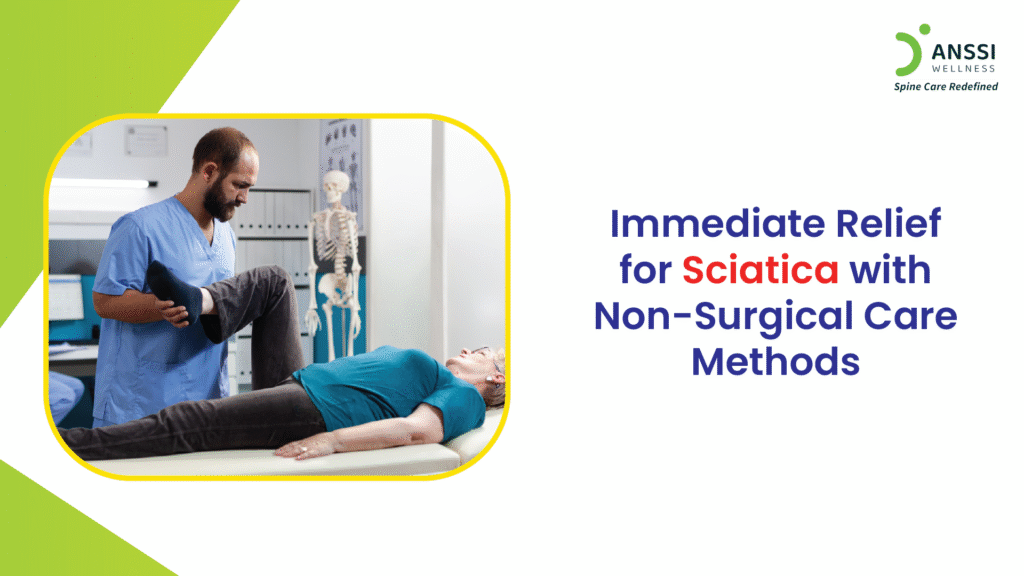Millions of individuals worldwide suffer from sciatica, one of the most prevalent causes of leg and back pain. The condition can be extremely uncomfortable, often interfering with everyday activities such as walking, sitting, or even sleeping. If you’ve ever felt sharp shooting pain traveling down your lower back into your buttocks or legs, chances are you’ve experienced sciatica.
The good news? Surgery is not always necessary. Many patients can achieve lasting relief through safe, non-surgical treatments that address the root cause of the problem. Let’s explore what sciatica is, why surgery isn’t always the best solution, and the non-surgical care methods that can bring immediate relief.
What is Sciatica?
Sciatica occurs when the sciatic nerve, the longest nerve in the body, becomes compressed or irritated. This nerve travels down each leg from the lower back via the hips. When compressed, it causes pain, tingling, numbness, or weakness along its path.
Common causes include:
- Herniated or slipped discs
- Spinal stenosis (narrowing of the spinal canal)
- Degenerative disc disease
- Poor posture or prolonged sitting
- Injuries or heavy lifting
Risk factors: Sedentary lifestyle, obesity, and occupations requiring long hours of sitting or standing can increase the likelihood of developing sciatica.
Why Surgery Might Not Be the Answer
When sciatica strikes, many people fear that surgery is the only answer. However, surgery should generally be considered a last resort.
Why?
- Invasiveness: Surgery involves cutting into tissues and may require long recovery times.
- Risks: Like any operation, spinal surgery carries risks such as infection, blood clots, or complications.
- Cost: Surgical procedures are often expensive compared to conservative care.
- Effectiveness: Many patients experience no relief after their surgery.
For most individuals, non-surgical treatments not only provide relief but also promote long-term healing.
Non-Surgical Care Methods for Immediate Relief
The goal of non-surgical care is to relieve pressure on the sciatic nerve, reduce inflammation, and restore mobility. Here are the most effective approaches:
1. Rest and Posture Correction
While complete bed rest is not recommended, taking short breaks and avoiding activities that worsen the pain can help. Maintaining proper posture while sitting or standing reduces stress on the spine. Use a chair with good lumbar support, avoid slouching, and stand with your weight evenly distributed.
2. Hot and Cold Therapy
Alternating between ice packs and heat therapy can bring quick relief.
- Cold packs reduce inflammation and numb sharp pain.
- Heat packs increase blood flow and relax tense muscles.
Applying these for 15-20 minutes several times a day can ease discomfort.
3. Stretching and Gentle Exercises
Targeted stretches release tension and relieve nerve compression. Simple movements such as knee-to-chest stretches, pelvic tilts, or gentle yoga poses can work wonders. Regular low-impact exercises like walking or swimming strengthen supporting muscles and prevent recurrence.
4. Physical Therapy
A trained physiotherapist can design customised exercises to strengthen your core and back muscles. These sessions focus on improving flexibility, mobility, and spinal alignment. Over time, physical therapy not only reduces pain but also prevents future flare-ups.
5. Non-Surgical Spinal Decompression Treatment
One of the most advanced methods for treating sciatica is Non-Surgical Spinal Decompression Treatment, a US-based protocol offered by specialised centres like ANSSI Wellness.
This treatment works by gently stretching the spine on a specialised machine, creating negative pressure within the spinal discs.
This process helps:
- Relieve pressure on the compressed nerve
- Promote retraction of herniated or bulging discs
- Improve blood flow and nutrient supply to the spine
- Accelerate the natural healing process
Unlike surgery, this treatment is completely non-invasive, drug-free, and pain-free. Patients often report significant pain relief after just a few sessions.
Lifestyle Modifications for Long-Term Relief
Along with treatment, lifestyle adjustments play a big role in managing sciatica:
- Stay active: Avoid prolonged sitting or standing in one position.
- Maintain a healthy weight: Extra body weight increases strain on the spine.
- Strengthen core muscles: Strong abdominal and back muscles provide better spinal support.
- Use ergonomic furniture: Invest in supportive chairs and mattresses.
- Lift carefully: Bend your knees, not your back, when lifting heavy objects.
About ANSSI:
ANSSI Wellness focuses on improving the quality of life for patients suffering from spinal issues, aiming to provide relief where other conventional treatments have failed. Through advanced Non-Surgical Spinal Decompression Treatment, ANSSI is committed to helping patients avoid surgery and recover in a safe, effective, and compassionate environment.
Connect with ANSSI Wellness on LinkedIn, Instagram, and Facebook for expert guidance.




